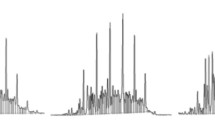Abstract
The successful application of total hydrocarbon analyzers to the analysis of hydrocarbon mixtures requires linear response with respect to a single calibration compound. Flame ionization detectors configured for total hydrocarbon analysis (premixed flames) do not respond in the same manner to all hydrocarbon species. A discussion of the source of the phenomena is presented.
An investigation is presented illustrating the problem in application of the technique to total hydrocarbon analysis of motor vehicle exhaust samples. The response of the nine most abundant auto exhaust hydrocarbons relative to propane, the compound commonly utilized for calibration, is defined for two commercial analyzers. The hydrocarbons selected for the investigation include methane, isopentane, isooctane, ethylene, propylene, acetylene, benzene, toluene, and p-xylene.
Analytical error predictions are made based on calculations utilizing the relative response and abundance of these hydrocarbons in samples from motor vehicles. Both catalyst equipped and non-catalyst vehicles are used as sources. The validity of the calculated predictions is empirically verified by comparison with total hydrocarbon levels obtained by summing the concentrations of the individual hydrocarbons obtained with gas chromatography.
Procedures to minimize the potential error are presented. The degree of improvement in hydrocarbon response linearity attainable through detector sample flow rate reduction is presented.
Similar content being viewed by others
References
Bruderreck, H., Schneider, W., and Halasz, I.: 1964, Anal. Chem. 36, 461.
Coordinating Research Council: 1966, Thirty Rockefeller Plaza, N.Y., ‘The Oxygen Effect in Flame Ionization Response to Hydrocarbons’, CY 65 Report Project No. CM-4-58: Exhaust Emission Measurements.
Cullis, C. F., Fish, A., and Turner, D. W.: 1962, Proc. Roy. Soc. (London) A267, 433.
Dimitriades, B. and Seizinger, D. E.: 1971, Environ. Sci. Technol. 5, 223.
Ettre, L. S.: 1962, J. Chromatog. 8, 525.
Federal Register: 1972, 37 (221), 24270.
Green, J. A. and Sugden, T. M.: 1963, Ninth Symposium (International) on Combustion, Academic Press, N.Y., p. 607.
Hainova, O., Bocek, P., Novak, J., and Janak, J.: 1967, J. Gas Chromatog. 5, 401.
Hurle, I. R., Sugden, T. M., and Nutt, G. B.: 1969, Twelfth Symposium (International) on Combustion, The Combustion Institute, Pittsburgh, p. 387.
Jackson, M.W.: 1966, J. Air Pollution Control Assoc. 11, 697.
Schofield, K.: 1974, Environ. Sci. Technol. 8, 826.
Sternberg, J. C., Galloway, W. S., and Jones, T. L.: 1962, in Brenner, Callen and Weiss (eds.), Gas Chromatography, Academic Press, N.Y., p. 231.
Author information
Authors and Affiliations
Rights and permissions
About this article
Cite this article
Black, F.M., High, L.E. & Sigsby, J.E. The application of total hydrocarbon flame ionization detectors to the analysis of hydrocarbon mixtures from motor vehicles, with and without catalytic emission control. Water, Air and Soil Pollution 5, 53–62 (1975). https://doi.org/10.1007/BF00431579
Received:
Revised:
Issue Date:
DOI: https://doi.org/10.1007/BF00431579




